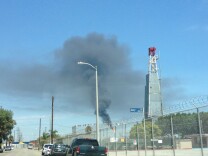
Next Up:
0:00
0:00
-
Listen Listen
Climate & Environment
Some of the country's highest home insurance prices are in the central U.S., a region generally considered to be protected from climate-driven disasters.
Listen
4:32
Sponsor
More Stories
-
State officials say they need a relatively new technology to achieve state climate goals. Opponents say it's just another lifeline for fossil fuels.
-
We’ve compiled dozens of tips to help get you through the rising temperatures in Southern California — from heat illness signs to finding a place to cool down.
-
You may have noticed you're being bitten here there and everywhere this year. Enjoy being dinner for the pesky bugs.
-
To state the obvious: California has a water problem. But experts say conservation alone can’t solve our water woes. Should recycled sewage water play a bigger role?
-
A California Newsroom investigation finds that the department's missteps potentially leave the state at greater risk of catastrophic fires.
-
Is it a lonely male looking for love? Call it a Tinder for birds.
-
This summer, millions of Angelenos can't use use drinkable water for outdoor irrigation more than twice a week. Here are tips how to conserve.
-
The final and most critical analysis yet from the United Nations Intergovernmental Panel on Climate Change lays out a stark picture of the future. Here's what that means for L.A.
-
From drenched Decembers to a record hot Super Bowl, we've seen winter on a rollercoaster in Southern California. Why?
-
Starting Jan. 1, 2022, California residents and businesses have been required to separate “green waste” from other trash and recycling. It’s a way to reduce the planet-heating greenhouse gases emitted by decomposing food in our landfills.
-
If you live near a steep, mountainous area that’s burned some time in the past few years, you need to prepare for debris flows when it rains.
-
Over the last year and a half, almost four dozen Cal Fire firefighters have suffered from heat illness during training, and since 2003 five have died.
Researchers found that in drier years, larger animals are more likely to head closer and closer to where people live.
Listen
4:05
Support your source for local news!
In case you missed it
-
911 recordings obtained by LAist shed light on why and how emergency planning continues to leave people with disabilities behind.
-
LAist investigates illicit dumping at three Antelope Valley sites.
-
An LAist investigation found toxic heavy metals in samples of fire retardant collected from the Palisades, Eaton and Franklin fires. Here's what that means.
More Stories
-
Soak in this warm day before the next storm system moves in, bringing much cooler temps starting tomorrow.
-
Cloudy skies and light showers today, more rain expected by the end of the week.
-
Climate change and pesticide use play a big part in their dwindling numbers, but habitat loss is the biggest factor in their decline.
-
Extreme wildfires have destroyed about one-fifth of all giant sequoia trees. To safeguard their future, the National Park Service is planting seedlings that could better survive a hotter climate.Listen 6:47
-
Scattered showers and a look ahead to more rain by the end of the week.
-
Aerosol pollutants have masked the effects of global warming. Without them, the U.S. is about to get a lot wetter.
-
A new report finds that one in four people in the U.S. are breathing unhealthy air as rising temperatures and bigger fires create a "climate penalty."
-
For children living near U.S. highways, a transition to zero-emission electric vehicles will mean reduced exposure to dangerous exhaust.
-
A lot of it runs out to the ocean, but we do manage to capture hundreds of thousands of acre-feet a year.
-
The state's parks department is working with stakeholders, including the military, to rebuild the San Onofre road, but no timeline has been given.




































